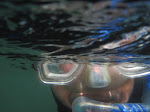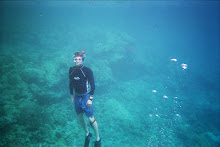 Looking from the water toward the land.
Looking from the water toward the land. Can you see the edge of the wave, the crest, that's just passed me heading for the shore? I've ridden the elevator up for the view.
You can see the wave beginnning to break there to the right. I don't recall if any of the three or four surfers out there caught this one or not.
The swell action: another reason to get in the water. Good exercise; good fun.
Good practice for rough water entries up north or anywhere, frankly. Abalone diving at Salt Point and Kruse Ranch gave me the taste for lively water. On this day, for the practice, I entered the water from the rocky little beach on the west side of Lover's Point; the waves were breaking at the foot of the steps from the parking lot (for those who know the spot). I waited for a lull, shuffled sideways down the speck of beach with my fins on, and dove into the water, swimming strongly to avoid the next set of waves. Then, I swam just beyond and amongst the rocks on that west side, playing with the surge.
Playing cautiously with the surge, I'll note. I was free diving solo, something I've been doing for about 15 years, and the swell was quite strong. A lot of energy out there, which is why I was out there too. Not to be a hero, not to be a fool, but to be a diver, to dive and swim with all that liveliness, the shove and lift of these waves. Then, I swam around to the east, staying well off the rocks, for the most part, and looking for the surfers riding the break on the point itself. (I stay out of their way, of course.) I spent some time watching the surfers, noting where and when they were taking off, thinking about how to take good photos without getting hammered on the rocks below. I left that venture for another day and continued swimming and diving.
The visibility was generally poor, of course, with all that churning, but it was still fun to explore underwater, searching for fish and other creatures. I swam further around to check the exits on the two beaches there. Despite the waves hitting the breakwater itself, there was an exit waiting for me--I'd checked before getting in--on the easternmost beach, the one by the kayak and board rental booth. Somewhat surprisingly, children were even playing in the shelter of the breakwater; I hope their parents or older siblings were at hand.
If that exit hadn't been waiting? If the swell had shifted so that waves were hammering that beach?
I would still have options. I could swim back around to the west and exit at my original entry point. For, if the swell had shifted to hit the beach behind the breakwater, then the speck of beach by the steps would be fairly calm, sheltered from the swell by the point itself.
Or, I could wait for a lull. Watch for a rhythm in the waves coming in, time the sets, and bet on picking a good break between sets. Just like picking waves to surf, but switching the last move to catch the lull instead of the lift.
In the worst case, no lulls and a building swell, I'd pick my wave and head for the soft landing of the sandy beach. (Up north on the Sonoma Coast, while abalone diving, sandy landings are a luxury or merely a myth.) Here, in that worst case, I'd pick my wave, power into it, ride it in, and then try my hardest to pull back into the wave itself, away from the breaking lip, to wash up on the sand with the back of the wave. However I hit the sand, with the lip or the back, I'd then crawl as quickly as possible away from the breaking surf and up onto the dry sand. I wouldn't be stopping to take off my fins or my mask until well beyond the water's reach.
But that's all basic training for diving, right? If you enter the water, have plans for getting out. And practice in different conditions, not merely on the calmest of days.
Scuba divers, if you practice without the tanks, you enjoy the glory of free diving and you'll be that much better navigating amongst rocks and surge even with your tanks. Then, practice with the tanks on too, for those times when the conditions turn a lot rougher than you anticipated. (Or, practice for those rougher days when you'll leave the tanks in the trunk and still get wet.)
But free dive first, and then again. Free dive.



















